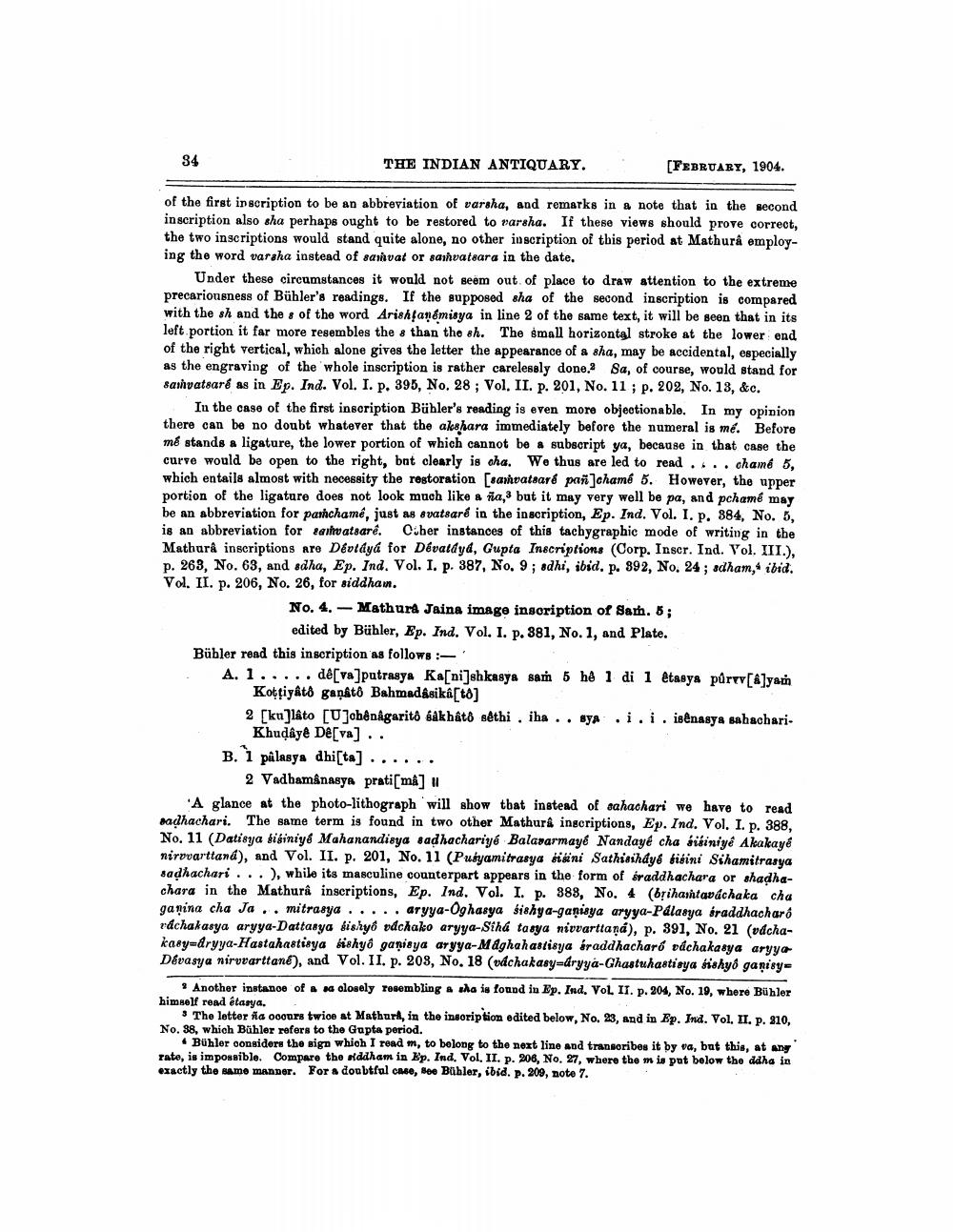________________
34
THE INDIAN ANTIQUARY
[FEBRUARY, 1904.
of the first inscription to be an abbreviation of varsha, and remarks in a note that in the second inscription also sha perhaps ought to be restored to varsha. If these views should prove correct, the two inscriptions would stand quite alone, no other inscription of this period at Mathura employing the word varsha instead of sanhvat or savatsara in the date.
Under these circumstances it would not seem out of place to draw attention to the extreme precariousness of Bühler's readings. If the supposed sha of the second inscription is compared with the sh and the , of the word Arishlarémisya in line 2 of the same text, it will be seen that in its left portion it far more resembles the 8 than the sh. The small horizontal stroke at the lower end of the right vertical, which alone gives the letter the appearance of a sha, may be accidental, especially as the engraving of the whole inscription is rather carelesely done. Sa, of course, would stand for saihvatsaré as in Ep. Ind. Vol. I. p. 395, No. 28; Vol. II. p. 201, No. 11; p. 202, No. 13, &c.
In the case of the first inscription Bühler's reading is even more objectionable. In my opinion there can be no doubt whatever that the akshara immediately before the numeral is me. Before me stands a ligature, the lower portion of which cannot be a subscript ya, because in that case the curve would be open to the right, bot clearly is sha. W. thus are led to read .... chamá 5, which entails almost with necessity the restoration [saniratsaré pañ]chamé 5. However, the upper portion of the ligature does not look much like a na 3 but it may very well be pa, and pchame may be an abbreviation for parchame, just as svatsare in the inscription, Ep. Ind. Vol. I. p. 384, No. 5, is an abbreviation for lart atsaré. Ciber instances of this tachygraphic mode of writing in the Mathura inscriptions are Dévtáyá for Dévaldya, Gupta Inscriptions (Corp. Inscr. Ind. Vol. III.), p. 263, No. 63, and sdha, Ep. Ind. Vol. I. p. 387, No. 9; sdhi, ibid. p. 892, No. 24; sdham, ibid. Vol. II. p. 206, No. 26, for siddham.
No. 4. - Mathura Jaina image insoription of Sam. 5;
edited by Bühler, Ep. Ind. Vol. I. p. 381, No. 1, and Plate. Bübler read this inscription as follows:-' A. 1.. ... de[va]putrasya Ka[ni]shkasya sa 5 hd 1 di 1 etasys purvv[6]ya
Kottiyâtð ganktô Bahmadásiká[t8] 2 [ku]lato [U]chênîgaritô gákhâtð sethi iha .. sya .i.i. isênasya sahachari
Khudâyê Dê[va] .. B. 1 palasya dhi[ta] ......
2 Vadhamanasya prati[m] H A glance at the photo-lithograph will show that instead of sahachari we have to read madhachari. The same term is found in two other Mathura inscriptions, Ep. Ind. Vol. I. p. 388, No. 11 (Datisya figiniye Mahanandisya sadhachariyé Balararmay& Nandayé cha sisiniye Akakaye nirvvarttand), and Vol. II. p. 201, No. 11 (Puśyamitrasya disini Sathiihdys sibini Sihamitrasya sadhachari ...), while its masculine counterpart appears in the form of sraddhachara or shadhachara in the Mathurâ inscriptions, Ep. Ind. Vol. I. p. 388, No. 4 (bțihashtaváchaka cha gamina cha Ja.. mitrasya . . . . . aryya-Oghasya sishya-ganisya aryya-Palasya sraddhacharo rdchakasya aryya-Dattasya sishy odchako aryya-Siha tasya nivvarttaná), p. 391, No. 21 (vdchakasy-dryya-Hastahastisya bishyo ganiaya aryya-Maghahastisya braddhacharó váchakasya aryya Devasya nirvrarttané), and Vol. II, p. 208, No. 18 (váchakasy-dryya-Ghastuhastisya sishyð ganisy
Another instance of closely resembling a tha is found in Ep. Ind. VOL. II. p. 204, No. 19, where Bühler himself read étasya.
The letter na ooours twice at Mathura, in the inscription edited below, No. 23, and in Ep. Ind. Vol. II, p. 310, No. 38, which Bühler refers to the Gupta period.
Bühler considers the sign which I road m, to belong to the next line and transoribes it by va, but this, at ang rate, is impossible. Compare the siddham in Ep. Ind. Vol. II. p. 206, No. 27, where the mis put below the ddha in exactly the same manner. For a doubtful care, He Bühler, ibid. p. 209, noto 7.




